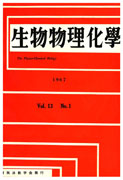All issues

Successor
Volume 13 (1967 - 196・・・
- Issue 4 Pages 231-
- Issue 3 Pages 177-
- Issue 2 Pages 81-
- Issue 1 Pages 1-
Volume 13, Issue 4
Displaying 1-4 of 4 articles from this issue
- |<
- <
- 1
- >
- >|
-
1968Volume 13Issue 4 Pages 231-293
Published: September 20, 1968
Released on J-STAGE: March 31, 2009
JOURNAL FREE ACCESSDownload PDF (25002K) -
Dose rate effects on serum protein in whole-body irradiated mice, 2Kenji Sato1968Volume 13Issue 4 Pages 295-298
Published: September 20, 1968
Released on J-STAGE: March 31, 2009
JOURNAL FREE ACCESSThe dose rate effects on serum protein fractions and acute mortality in whole-body irradiation of DDY strain male mice were studied.
There was a small but definite dose effect on deaths occurring within 20 days.
Mice which died within 10 days after irradiation were less in number in lower dose rates than in higher dose rates under the same total dose.
Total serum protein and serum albumin of mice which received 800R of irradiation decreased, and α- and β-globulins increased, with increase in dose rates.View full abstractDownload PDF (470K) -
Shinzo Nishi1968Volume 13Issue 4 Pages 299-306
Published: September 20, 1968
Released on J-STAGE: March 31, 2009
JOURNAL FREE ACCESSPlasma protein fractions of forty six cases of healthy adult Japanese, male and female, between 18-59 years old, were analyzed by Tiselius as well as cellulose acetate membrane electrophoresis.
The results were as follows:
In comparison with the nomal values determined before 1955, present data indicated definitely an increase of albumin and a decrease of γ-globulin.
The accuracy of the both methods was also checked by repeating the determination.View full abstractDownload PDF (507K) -
Tadashi Kawai1968Volume 13Issue 4 Pages 307-316
Published: September 20, 1968
Released on J-STAGE: March 31, 2009
JOURNAL FREE ACCESSThe characteristic wavy band is recognized exclusively in association with IgG-myeloma protein. The pseudo-wavy band is also seen in some cases of IgG-myeloma, as well as IgA-myeloma, macroglobulinemia, IgG-benign monoclonal gammopathy and hypergammaglobulinemia such as liver cirrhosis, chronic thyroiditis, renal cell carcinoma and reticulum cell sarcoma.
Formation of the wavy band depends on both the nature of the abnormal globulin involved and the property of the supporting medium used. The more the reduced specific viscosity of the abnormal globulin, the more the tendency of forming the wavy band. In addition, the pores in the supporting medium should be small and irregular in their size, in order to develop the characteristic wavy band. It is most characteristically demonstrated on Oxoid and Separax membranes. Among other cellulose acetate membranes, Millipore and Sepraphore III membranes have the least tendency to form the wavy band.View full abstractDownload PDF (7785K)
- |<
- <
- 1
- >
- >|